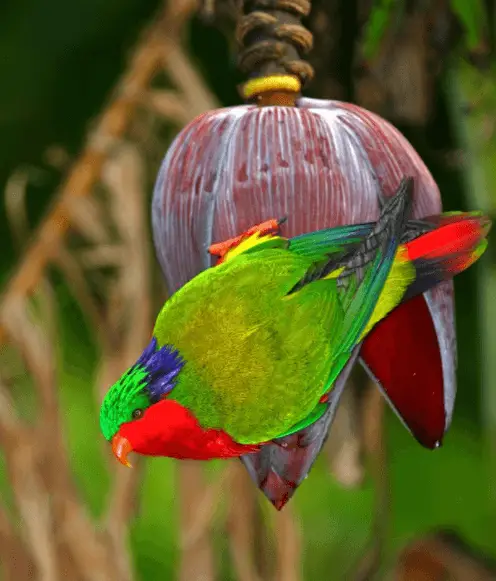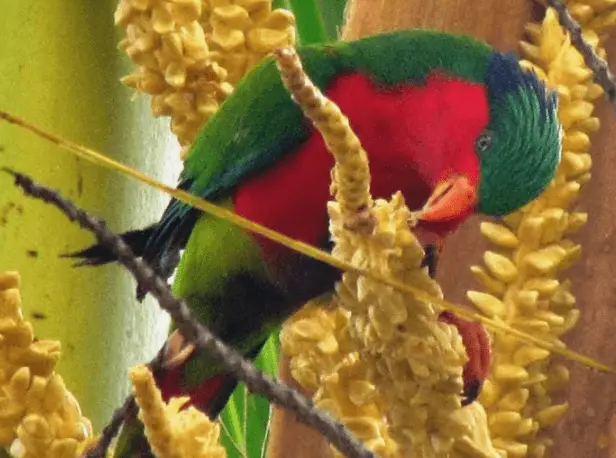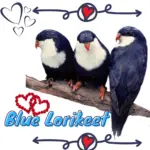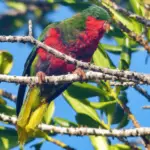
Kuhl’s Lorikeet 19 cm. Bill orange; crown above a line through eye green and nape purplish-blue, all with slightly elongate feathers; underparts red; thighs purple;
mantle green shading darker on wings and to yellowish on back, rump, upper- and under tail-coverts and vent; tail above dark reddish centrally with dark outer feathers, greyish below; legs orange-brown. Immature barred purple below, less red in tail.
Monotypic.
Subspecies
Introduced to Teraina (Washington), Tabuaeran (Fanning), and Kiritimati (Christmas), in N Line Is (Kiribati), and to Atiu, where the species was present, as in other S Cook Is, in prehistoric times.
Distribution
Rimatara, in Tubuai, Is (French Polynesia).
SOURCE:ParrotsWhispering
Habitat
On Rimatara birds appear to favor the mixed horticultural belt (61% of the population in 32% of its available area), being uncommon in coastal coconut plantations and rare in makatea forest.
On Teraina birds use all terrestrial habitats including coconut-dominated forest, stands of Pisonia grandis, Pandanus areas, and a coastal fringe of Messerschmidtia argentea, Scaevola taccada and Cordia subcordata.
Movement
Sedentary.
The Kuhl’s Lorikeet – EN (2012)
SOURCE:AV/DGEE
Diet and Foraging
On Rimatara 12 recorded foodplants (flowers) in Aug, in descending order of importance, were: Inga ynga, Casuarina equisetifolia (seeds), Paraserianthes falcataria, Musa, Mangifera, Ceiba pentandra, Cocos nucifera, Hibiscus rosa-sinensis, Erythrina variegata, Adenanthera pavonina, Syzygium Jambos, Albizia lebbeck; at other seasons flowers of Coffea arabica and Hibiscus tiliaceus and rotting leaf borders of Barringtonia Asiatica.
On Teraina Terminalia catappa and Premna obtusifolia noted.

Sounds and Vocal Behavior
Kuhl’s Lorikeet Calls include high-pitched shrill notes, typically modulated, such as “tsi-eet” or “tsee-u-eet”. When perched, also lower-pitched squeaky nasal notes.
Breeding
Jan–Apr. Kuhl’s Lorikeet Nests in coconut palms, once reportedly in the rotten trunk of a Pandanus. In captivity: 2 eggs; nestling period c. 7 weeks.
Conservation Status
ENDANGERED. CITES II. A BirdLife “restricted-range” species.
The Kuhl’s Lorikeet was almost certainly introduced to Tabuaeran and Teraina and is known to have been to Kiritimati. It is not common on Rimatara, it’s one remaining native island, with a total population of 900 estimated in Aug 1992.
Fewer than 50 were judged present on Tabuaeran in Feb 1993, apparently having declined in response to colonization by the black rat Rattus rattus. On Teraina 1000–1600 birds were estimated present in Feb 1993.
On Kiritimati, a few birds survive from several small releases since 1959, but conditions on the island are unfavorable. Extinction on other islands in the Cooks appears to be the result of over-exploitation for use of feathers by native peoples. Introduction to ‘Atiu, free of black rats, should be undertaken.
There is a clear need for greater awareness of the international significance of Teraina’s population. Keeping black rats off both Rimatara and Teraina is essential.




















